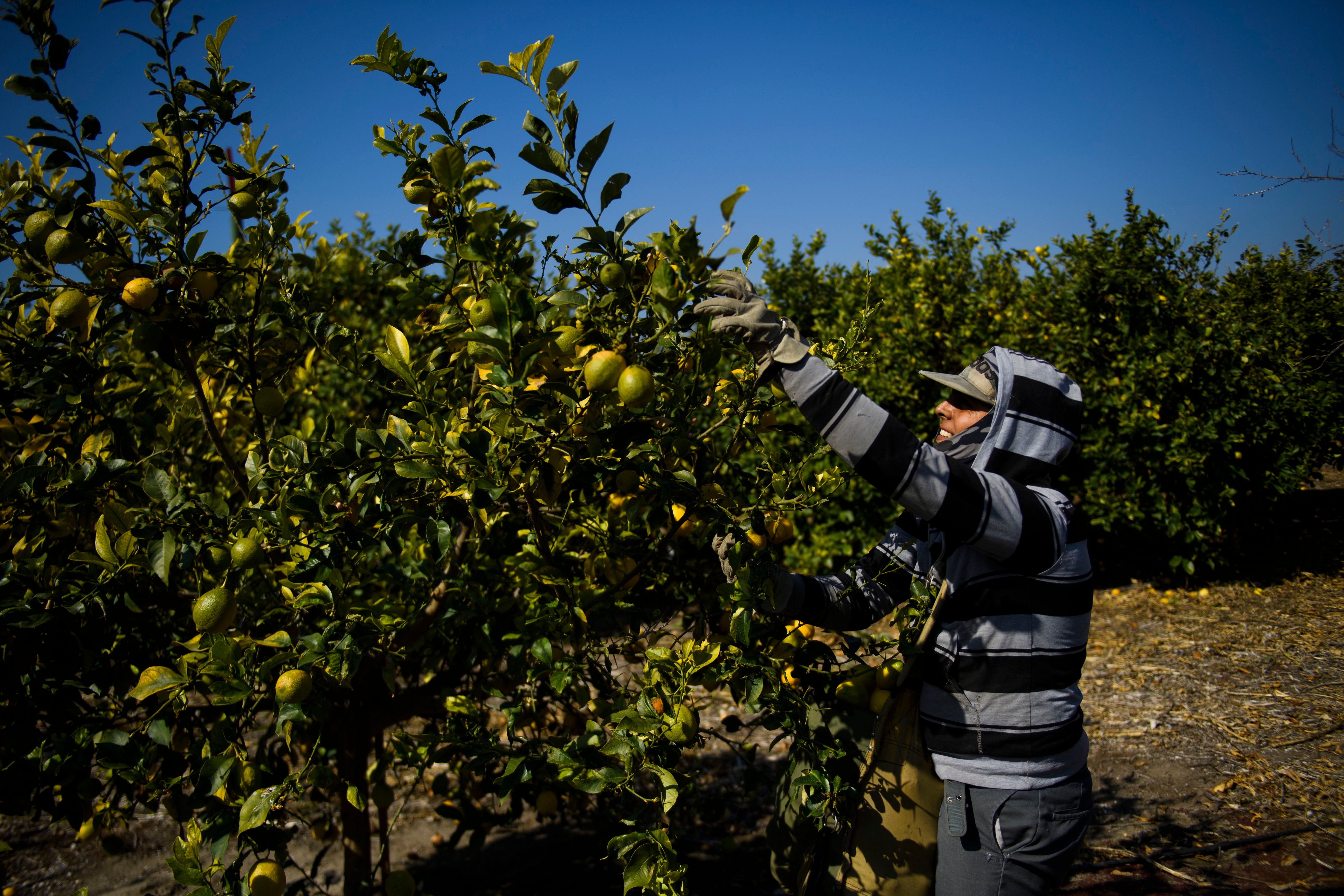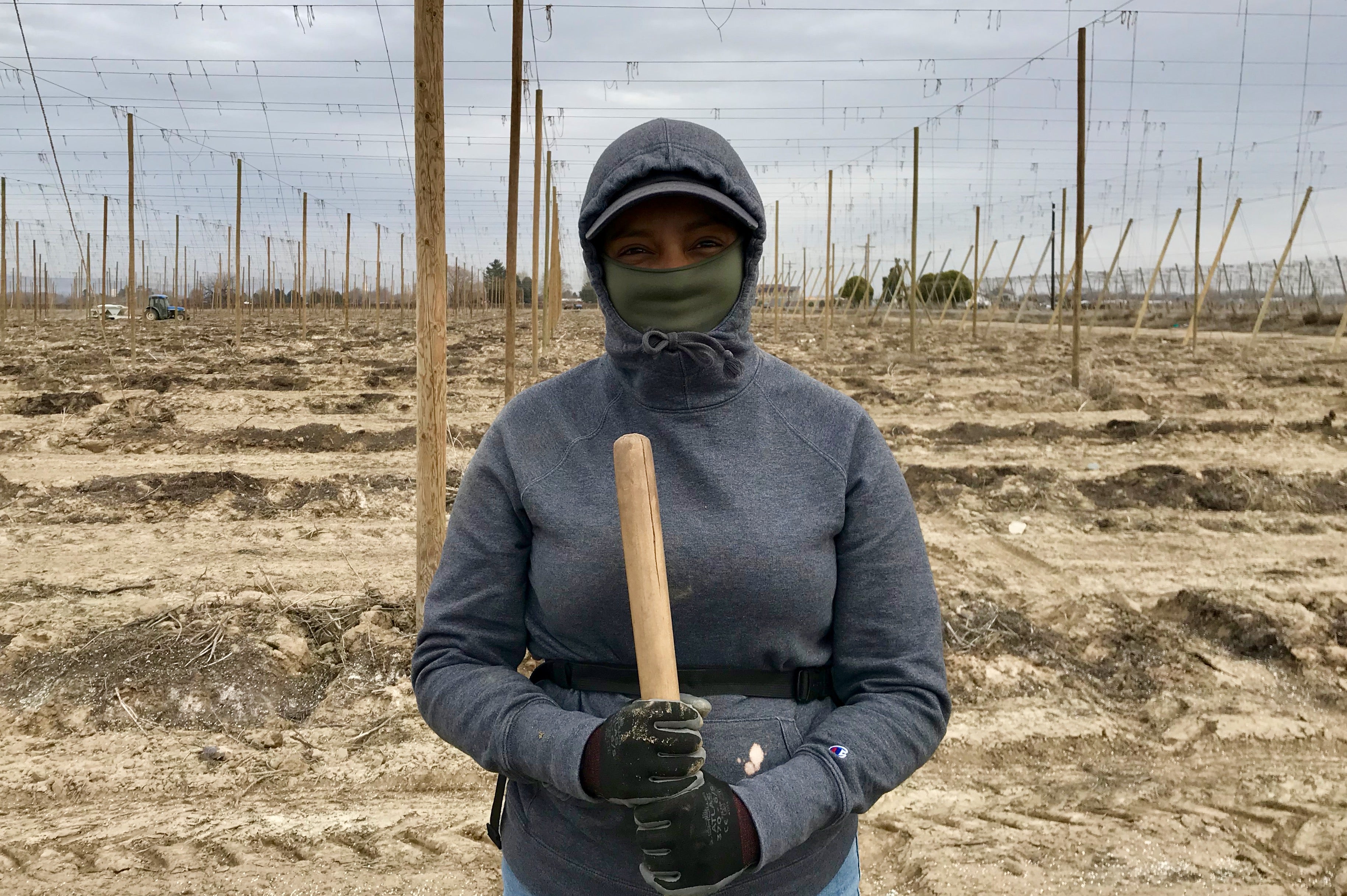‘We cannot harvest our food remotely’: Farm workers anxiously await their turn for vaccinations
Planting and picking America’s food is an essential role in the pandemic, writes Andrew Buncombe, but for Washington state’s migrant workers, it’s been a long wait for the jab that will take their worries away


The man with the apple trees did not want to get sick. And neither did he want to wait his turn to get vaccinated. So the 60-year-old and his brother drove to Seattle, flew to Oakland, California, where many counties had prioritised farm workers, and got the jab. They then flew home.
“There was no paperwork, nothing,” says the man, who asks not to be named. “We have some relatives there. They just put our names on the list.”
None of the men employed by the cheerful farmer, who gently lists off the varieties of apples he grows on his 450 acres – gala, granny smiths, ambrosia, golden delicious, red delicious – have the means to do the same. The same goes for the bulk of the several million farm workers engaged in one of the most fundamental of tasks, whether or not they officially qualify as “essential worker” – growing the nation’s food.
“One of our campaigns since everything happened has been to try to get these people protected,” says Edgar Franks, political director of Familias Unidas por la Justicia, an independent labour organisation based in Washington state.
Read More:
“It has been a slow process, with a lot of setbacks.”
Twelve months ago, when “everything happened”, activists such as Franks spoke out for the need to protect farm workers at risk of catching the coronavirus. He pointed out the workers, large numbers of whom fly into the US every year from Mexico with special H-2 visas, were especially vulnerable.
Not only were many employers failing to provide sufficient masks and other such items for their workers, but large numbers of them were sleeping in small, cramped bunkhouses, sometimes with as many as eight or 10 others. It was impossible to maintain distance. And in the bunks, as in the fields, the opportunity for washing their hands, never mind with soap, was very limited.
At the beginning of March, a number of counties in California added farm workers to the list of those eligible to obtain the Covid jab. Health officials started vaccinating people in the strawberry fields and mushroom plants. Unions said it was a critical development to protect their members.
But here in Washington state, as well as places such as Texas and Florida which employ large numbers of farmworkers, many of them seasonally, officials were slower to act. In Washington, the governor Jay Inslee added farm workers, police, grocery store employees and firefighters to those scheduled to be vaccinated on 22 March.
In the Yakima Valley, 150 miles southeast of Seattle, generations of migrant labourers have turned the region into the nation’s top producer of apples, cherries, grapes and pears.
The Yakima resident who erected a sign on Interstate 82 may have been gently winking when it named the city the “Palm Springs of Washington”, a reference to the celebrated and stylish spa town in California, but it has its own microclimate, which is markedly warmer than on the coast.
The work is backbreaking. Early starts, long days, few facilities to escape the heat. Most of the workers try to cover every scrap of skin to protect it from the elements ... they have also been wearing masks
Indeed, while winters are hard and bitter, summers here can fry the brain. The best time, both for workers and for visitors, is spring. Right now, the valley is lit with new growth, blossoms and birdsong.
In each and every direction, workers are readying the land, burning last year’s stubble or old growth, setting up frames from which will grow hops, or repairing water pipes or power lines. In the coming weeks, they will be joined by thousands more, helping harvest some of the early crops such as asparagus. Many of the H-2 visa workers from Mexico are employed by the same farm, year after year, before returning home in the autumn.
While it is soft to the eye, the work is backbreaking. Early starts, long days, few facilities to escape the heat. Most of the workers try to cover every scrap of skin to protect it from the elements; this past 12 months they have also been wearing masks.
And when The Independent visits one constant theme is the lack of information about when precisely people can get the vaccine, and whether it will be available to everyone, including those arriving from Mexico. (A spokesperson for the Washington health department confirms every individual living or working in the state who meets the requirements of the various tiers is eligible for vaccination.)
I think we should get the vaccine early, but three weeks [from now] is good
A number of farm workers are pleasantly surprised to learn they can get the vaccine from 22 March, thinking it might be much later, even as Joe Biden vows to make every adult eligible to get a shot by the beginning of May.
“I think we should get the vaccine early, but three weeks [from now] is good,” says Vitalino Soto, one of the workers whose boss had flown to California. “This is the first time I have heard this.”
The 41-year-old, who has worked in the valley for the past 13 years and who originally came from Mexico, says the last 12 months had been difficult. While he has the relative luxury of returning home at night to his wife and children, rather than a shared bunkhouse, the threat of the virus has never been far away.
“Lots of people have died. It’s something that we think about,” he says.
Janet Delgado is working with a group of people a few miles from the apple farm. The 23-year-old, who was born and grew up in the town of Toppenish, also does not know about the March 22 vaccination date.
“Right now, we’re just replanting hops,” she says, after getting permission from the forewoman to take a quick break. “We started at 7am, and we will finish at 3.30pm.”

She says all the workers have been wearing masks. And they have been trying to maintain space between each other while they go about their tasks. Asked if she realises the vital role carried out by her and her colleagues, she says: “Yes. We do feel important.”
She says they are all ready to get vaccinated, despite hearing false reports of people becoming ill after taking the shot.
“I guess we all heard rumours about people getting infections with the vaccine, and I guess we’re all scared of that,” she says. “But at the same time, we all think about it and we have to get it so we can move on with this.”
One of the places that has played an important role in vaccinating people and providing information about the vaccines to try to assuage concerns is the Yakima Valley Farm Workers Clinic. It was established in 1973 and now has 40 locations across Washington and neighbouring Oregon.
It is a non-profit organisation, and on the wall of its clinic in Toppenish there is a striking image of farm workers, or braceros, as migrant workers from Mexico were originally known. The mural was painted by the celebrated Latino artist Daniel DeSiga, who was born in nearby Walla Walla and who died last year.
Earlier this month, the clinic was one a few dozen institutions that cater “to hard-to-reach and disproportionately affected populations” for a trial programme, in which they would be directly provided with vaccines from federal government, rather than through the state.
We cannot harvest our food remotely. Our essential workers must do their jobs in person
“The allocation provided for this programme is separate from jurisdictions’ weekly allocations,” said the department of health and human services.
While the clinic must abide by state guidelines on who is eligible for vaccines, it has been allowed to be more proactive, contacting large numbers of employers in the valley and seeing if they have workers who fit the requirements: somebody 65 or older, or someone aged 50 and living in a group house who has not been vaccinated.
Lori Kelley, senior director of quality at the clinic, says staff are excited to be involved in something that can save lives, especially after the past 12 months when it was seeing so much sadness and pain in the valley. “This is our community,” says Kelley. “We can have a great impact.”
Of the role farm workers in Yakima have long played in helping feed the nation and the importance of keeping them safe, she says: “We cannot harvest our food remotely. Our essential workers must do their jobs in person.”
On the morning of The Independent’s visit, an 84-year-old man, Ray Heilman, is getting his second shot of the Moderna vaccine.
Heilman knows the rigours of farm work: until he retired eight years ago, he raised wheat, sugar beets and alfalfa in Harrah, 10 miles west of Toppenish. He and his wife, Barbara, have four children, though they had barely seen them this past 12 months. The couple say several of their friends and neighbours died from the illness.
“The worries went away when I got vaccinated,” he says of the booster jab.
Read More:
At a farm in the middle of the valley, Geraldo Valladares is waiting for his chance to get vaccinated and for his “worries” to go away too. He is a foreman with one of the valley’s larger operators, one that employs many migrant workers from Mexico. His mother and father, Roberta and Geraldo, chuckle when they recall the long hours and hard work they put in when they worked these same fields more than 40 years ago, having originally come from Mexico.
He says before the workers from Mexico arrive in the US, they get tested for the virus. When they reach the valley, they do what they can to keep everyone safe. Valladares, 51, says those workers should also be eligible for a shot.
“I think it would be much safer for everyone is they got the vaccine too,” he says. “I’ve not had it yet, but I will be happy to get it. I think everyone will be happy to get the shot.”
Join our commenting forum
Join thought-provoking conversations, follow other Independent readers and see their replies
Comments